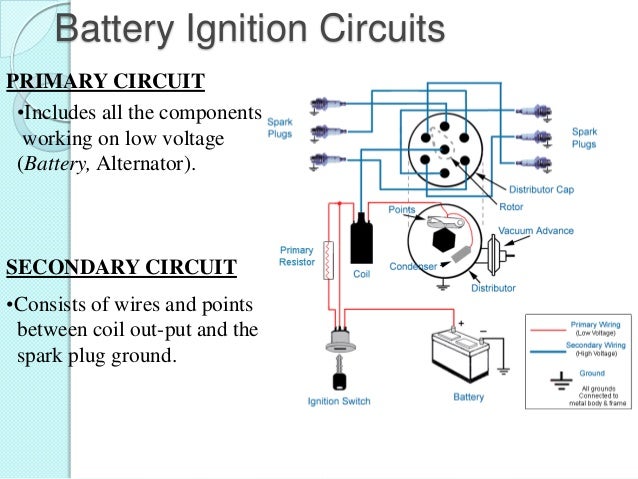Most of the
modern spark-ignition engines use battery
ignition system. The essential components of battery ignition system
are a battery, ignition switch, ballast resistor, ignition coil, breaker
points, condenser, capacitor distributor and spark plugs.
The breaker
points, condenser, distributor rotor and the spark advance mechanisms are
usually housed in the ignition distribution. The breaker points are
actuated by a shaft driven at half engine speed for a four stroke cycle
engine. The distributor rotor is directly connected to the same shaft.
The system has a
primary circuit of low-voltage current and a secondary circuit for the
high-voltage circuit.
The primary
circuit consists of the battery, ammeter, ignition switch, primary coil winding
and breaker points. The primary coil winding usually has approximately 240
turns of relatively heavy copper wire wound around the soft iron core of
ignition coil.
The secondary
circuit contains the secondary coil windings, distributor, spark plug leads and
the spark plug. The secondary windings consists of about 21000 turns of
small, well insulate copper wire.
Schematic
diagram of Battery Ignition System

When the
ignition switch and the breaker points are closed a low-voltage current flows
from the battery through the primary circuit and builts up a magnetic field
around the soft iron core of the ignition coil.
When the breaker
points are opened by the action of the cam on the distributor shaft, the
primary circuit is broken and the magnetic field begins to collapse, an induced
current from the collapsing magnetic field flows in the same direction in the
primary circuit as the battery current and charges the condenser which acts as
a reservoir for the flowing current due to a rapidly collapsing magnetic field,
high voltage is induced in the primary (it might be as high as 250 volts) and
even higher in the secondary (10,000 to 20,000 volts).
The high voltage
in the secondary passes through the distributor rotor to one of the spark plug
leads and into the spark plug. As soon as sufficient voltage is built up
in the secondary to overcome the resistance of a spark plug, the spark arcs
across the gap and the ignition of the combustible charge in the cylinder takes
place.
The induced
current in the primary to overcome the resistance of a spark across the gap and
the ignition of the combustible charge in the cylinder takes place. The
induced current is the primary, as it was pointed out above flows in the same
direction as it did before the breaker points opened up and charges the
condenser.
The increasing
potential of the condenser retards and finally stops the flow of current in the
primary circuit and the rapidly ‘backfires’ or discharges again through the
primary, but in the direction opposite to the original flow of
current. This rapid discharge of condense produces directional oscillation
in the current flow in the primary circuit.
This oscillation
is weekend with every succeeding reversal in the current flow until the
original potentials and the direction of current flow the primary circuit are
established. The discharge of condenser by itself does not produce the spark,
but only hastens the collapse of the magnetic field around the soft iron core.
The condenser,
which has a capacitance range from 0.15 to 0.24 mf in the automotive system,
not only assists in the collapse f the magnetic field, but also prevents arcing
at the breaker points by providing a place for the induced current to flow in
the primary circuit.
If the condenser
is too small or too large, the breaker points will lead to excessive pitting
will result the breaker points and the distributor must be carefully
synchronized with the crankshaft of the engine to give the proper timing of the
spark in each of the cylinders. The breaker is often refereed to as the
timer, since the time or point in the cycle that the spark occurs depends upon
the time of opening of the breaker points.
The spark plug
leads are called the ignition harness. Since the lead carry a very high
potential, a special insulation is required to prevent a short circuit. Even
with the special insulation, these leads are subjected to breakdowns which
result in high-tension short circuits and to leakage that lower the voltage
available at the work plug. Also, the leads should be shielded to aid in the
prevention of radio interference.
Comments